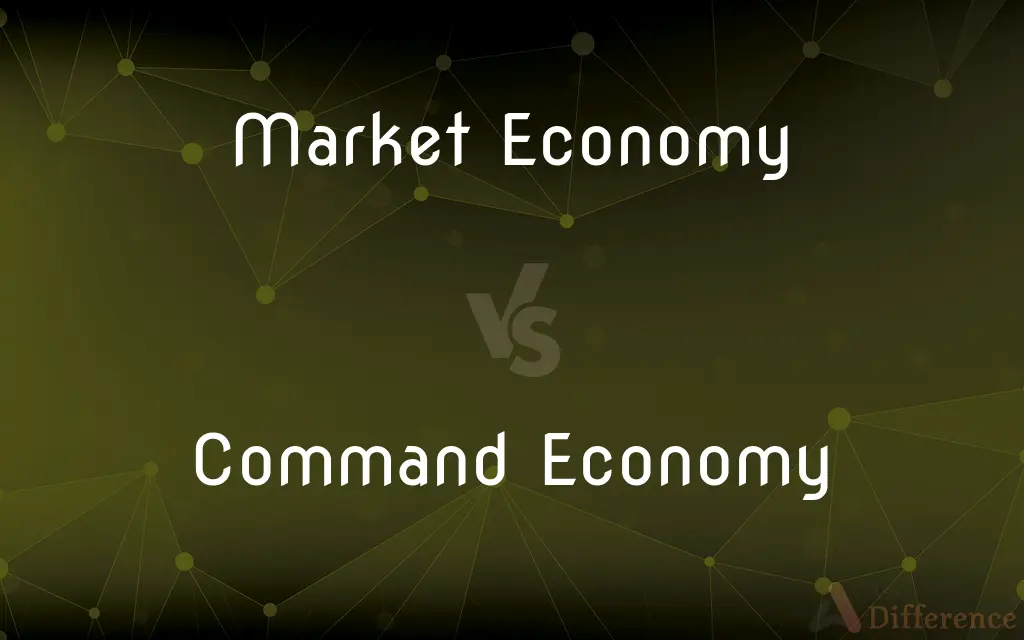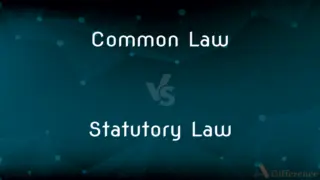Market Economy vs. Command Economy — What's the Difference?
By Tayyaba Rehman — Published on October 17, 2023
Market Economy allows supply and demand to dictate prices and production, while Command Economy involves the government making all economic decisions.

Difference Between Market Economy and Command Economy
Table of Contents
ADVERTISEMENT
Key Differences
Market Economy and Command Economy stand as two contrasting economic systems, each with unique attributes and inherent challenges. In a Market Economy, decisions regarding investment, production, and distribution are guided by individuals or corporations in the market. Contrarily, in a Command Economy, these decisions are regulated by the government or a central authority.
In the realm of a Market Economy, the forces of supply and demand predominantly determine the pricing of goods and services. Conversely, a Command Economy disregards these market forces, assigning prices through central planning. The Market Economy often provides a wider array of goods and services for consumers since companies compete to offer better, varied products. The Command Economy tends to restrict choices to what the government decides to produce.
When dissecting the dynamics of a Market Economy, one witnesses the invisible hand phenomenon, where businesses and consumers interact, and prices are adjusted based on collective behaviors. In stark contrast, a Command Economy operates under a visible hand, with government authorities meticulously orchestrating economic activities. Freedom and choice characterize the Market Economy, inviting innovative products and services due to competitive mechanisms. The predictability of availability and stability in prices is a feature of the Command Economy, albeit at the cost of innovation and variety.
A quintessential advantage of the Market Economy lies in its ability to adapt to consumer desires and technological advancements due to inherent competitive pressures. In comparison, the Command Economy can rapidly mobilize resources towards specific goals defined by the central authority, regardless of market demands. Market Economy encourages entrepreneurial activities and wealth creation, rewarding innovation and efficiency. In the backdrop, a Command Economy seeks to achieve socio-economic objectives and control disparities, albeit often culminating in inefficiencies and stagnation.
Individual prosperity and corporate profits frequently shape the contours of a Market Economy, aligning economic growth with wealth accumulation. Contrarily, a Command Economy, often driven by socio-economic objectives, could prioritize collective goals over individual prosperity. Notably, no economy is purely a Market Economy or Command Economy but usually exhibits a mix of both characteristics, forming a mixed economy.
ADVERTISEMENT
Comparison Chart
Decision-making
Driven by individuals/corporations
Centralized by government
Price Determination
Supply and demand
Set by the government
Resource Allocation
Through market forces
Planned by the government
Production Control
Private firms
Government
Consumer Choice
Wide range
Limited
Compare with Definitions
Market Economy
Market Economies often link wealth creation with innovation and efficiency.
In a Market Economy, innovative companies tend to be the most prosperous.
Command Economy
A Command Economy is structured such that the government controls and directs all economic activities.
In a Command Economy, the government decides what goods will be produced.
Market Economy
Market Economies tend to offer a wider variety of goods and services due to competitive mechanisms.
Consumers in a Market Economy enjoy a myriad of options for every product.
Command Economy
In a Command Economy, production goals and resource allocations are centrally planned.
The Command Economy determines how many units of a product will be produced.
Market Economy
A Market Economy primarily allows private entities to own and operate businesses.
The Market Economy encourages individuals to start their own companies.
Command Economy
Command Economies often seek to achieve socio-economic objectives through centralized planning.
A Command Economy might prioritize housing or healthcare for all citizens.
Market Economy
A Market Economy is an economic system where supply and demand control the production and prices of goods and services.
In a Market Economy, if a product is in demand, its price will rise.
Command Economy
Price and supply in a Command Economy are typically decoupled from demand and are determined by the government.
In a Command Economy, popular items may still be scarce if not prioritized by the government.
Market Economy
In a Market Economy, prices and production levels are determined through free-market competition.
The plethora of brands in the Market Economy creates vibrant competition.
Command Economy
Command Economies frequently curtail the variety of available goods and services to consumers.
Residents in a Command Economy have limited choices in retail stores.
Common Curiosities
How does competition function in a Market Economy?
In a Market Economy, competition is prevalent as companies vie for consumer attention and purchase.
What primarily drives a Market Economy?
A Market Economy is primarily driven by supply and demand.
Who makes the economic decisions in a Command Economy?
The government or a central authority makes all decisions in a Command Economy.
Can a Command Economy respond effectively to consumer demands?
A Command Economy may struggle to meet specific consumer demands due to centralized planning.
How are prices determined in a Market Economy?
Prices in a Market Economy are determined by supply, demand, and competition.
How does a Market Economy encourage innovation?
A Market Economy encourages innovation through competition and the pursuit of profit.
Can businesses operate freely in a Command Economy?
Businesses in a Command Economy operate as per government guidelines and planning.
How is resource allocation done in a Market Economy?
In a Market Economy, resources are allocated based on market forces and competition.
Are citizens’ choices limited in a Command Economy?
Yes, choices are often limited in a Command Economy to what the government decides to produce.
Is income inequality common in a Market Economy?
Yes, income inequality can be more pronounced in a Market Economy due to varied economic successes.
How does a Command Economy control production?
Command Economies control production through centralized plans and government directives.
Can a Command Economy ensure equal distribution of resources?
A Command Economy can aim for equal distribution but might struggle with efficiency and meeting preferences.
Are Market Economies capable of addressing social inequalities?
Market Economies might address social inequalities indirectly, and often rely on governmental social programs.
Can a Command Economy stimulate innovation and competition?
Command Economies often struggle with stimulating innovation due to lack of competitive drivers.
Are there pure Market Economies or Command Economies in the world?
Most countries operate mixed economies, combining aspects of both Market and Command Economies.
Share Your Discovery

Previous Comparison
Common Law vs. Statutory Law
Next Comparison
Coca-Cola Zero vs. Diet CokeAuthor Spotlight
Written by
Tayyaba RehmanTayyaba Rehman is a distinguished writer, currently serving as a primary contributor to askdifference.com. As a researcher in semantics and etymology, Tayyaba's passion for the complexity of languages and their distinctions has found a perfect home on the platform. Tayyaba delves into the intricacies of language, distinguishing between commonly confused words and phrases, thereby providing clarity for readers worldwide.













































